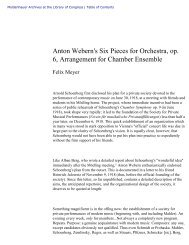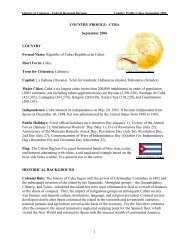1 - American Memory
1 - American Memory
1 - American Memory
Create successful ePaper yourself
Turn your PDF publications into a flip-book with our unique Google optimized e-Paper software.
170<br />
CLOTHINO<br />
Hawaii's garment industry produces island-style sportswear which meets<br />
some of the needs of local residents for work as well as play. But unlike the<br />
tourists in Walkiki, local residents don't normally spend all of their time in<br />
aloha shirts, muumuus, and bikinis. We need business suits and dresses, shoes,<br />
socks, or hose, sweaters, underwear—all of which must come from outside the<br />
State. One large Honolulu department store estimates that only 30 percent of<br />
its women's clothing and 20 percent of its men's clothing sales are of locally<br />
manufactured goods. Nearly all of the rest of its stock is brought In from the<br />
Mainland U.S.<br />
Even the local garment industry is by no means self-sufficient. There is no<br />
textile manufacturing In the State, except for the printing of some imported<br />
fabrics. Until recently around 90 i>erccnt of the fabric used by local garment<br />
manufacturers was imported from Japan. (While Japan remains the major<br />
supplier, revaluation of the yen and rising prices in that country have caused<br />
the industry to turn increasingly to other sources In Asia and the Mainland<br />
U.S.) Although only a local dock tie-up can seriously Interfere with the bulk of<br />
Hawaii's textile imports, since fabrics are largely of foreign origin, interruption<br />
on the Mainland-Hawaii route can still affect garment production. The industry<br />
relies on Mainland manufacturers for most of the buttons, zippers, and thread It<br />
uses.<br />
TBAN8P0BTATI0N EQUIPMENT<br />
With the exception of boats and specialized truck bodies (both made from<br />
imported materials), Hawaii manufactures no transportation equipment. All<br />
cars, trucks, bu.ses, airplanes, tires, batterle-s, and parts must be imported.<br />
Demand is substantial. In 1971, there were more than 42.j,000 motor vehicles<br />
registered in the State, and new cars sold in Honolulu County alone totaled<br />
more than 32,000.<br />
Over half of the cars brought Into Hawaii come from Mainland ports on U.S.<br />
vessels. In 1970, with no transportation tie-ups, <strong>American</strong>-made autos accounted<br />
for 60 percent of the new cars sold in Honolulu County. (In strike-plagued 1971,<br />
<strong>American</strong> cars fell to .51 percent of the total, but in 1972 they rebounded to 55<br />
percent.) The Increasingly popular Japanese makes, which have accounted for<br />
about one-third of new car .sales in Honolulu in recent years, are imported from<br />
the country of origin on foreign-flag vessels, as are Volkswagen and some other<br />
European cars. But several European makes and most EuroiJean auto parts are<br />
shipped to Hawaii from West Coast ports on <strong>American</strong> ships.<br />
OTHEB MACHINEBT<br />
Hawaii's almost total lack of metal resources makes the State ultimately de-<br />
pendent on im|)orts for all tyi)es of machinery—home, office, and industrial.<br />
There is some machinery manufactured locally, primarily agricultural equip-<br />
ment, but of course the raw materials are imported. All such goods as typewrit-<br />
ers, television sets, radios, refrigerators, computers, cash registers, clothes wash-<br />
ers and dryers, and communications equipment—as well as parts for all of<br />
them—must be brought in from either the Mainland U.S. or abroad.<br />
PAPEB AND ALLIED PB0DLCT8<br />
There are no pulp or paper mills In Hawaii. We depend on Imports, either In<br />
raw or finished form, for all of the paper products consumed in the State—paper<br />
towels, toilet parwr, and napkins for homes; stationery, enveloi)es, and printed<br />
forms for offices and banks; Industrial paper goods and containers for factories;<br />
and new.sprint and coated paper for the printing industr.v. In 1970, when ship-<br />
ping was normal, we imported more than 166.0(10 tons of pulp, paper, and printed<br />
matter. Around 38.000 tons was newsprint, which comes primarily from Canada.<br />
But of the remaining 128,000 tons, more than 9S percent came from the Main-<br />
land states.<br />
MEMCAL etJPPLIES<br />
Hawaii depends on Mainland U.S. manufacturers for all of Its drugs and<br />
hospital supplies. Because of the critical nature of these Items, of course, the<br />
State has never had to do without, even in the most serious transportation



![Albert Einstein Papers [finding aid]. Library of Congress. [PDF ...](https://img.yumpu.com/21604228/1/190x245/albert-einstein-papers-finding-aid-library-of-congress-pdf-.jpg?quality=85)





![American Colony in Jerusalem Collection [finding aid]. Library of ...](https://img.yumpu.com/17941275/1/190x245/american-colony-in-jerusalem-collection-finding-aid-library-of-.jpg?quality=85)



![Piccard Family Papers [finding aid]. - American Memory - Library of ...](https://img.yumpu.com/17941234/1/190x245/piccard-family-papers-finding-aid-american-memory-library-of-.jpg?quality=85)


